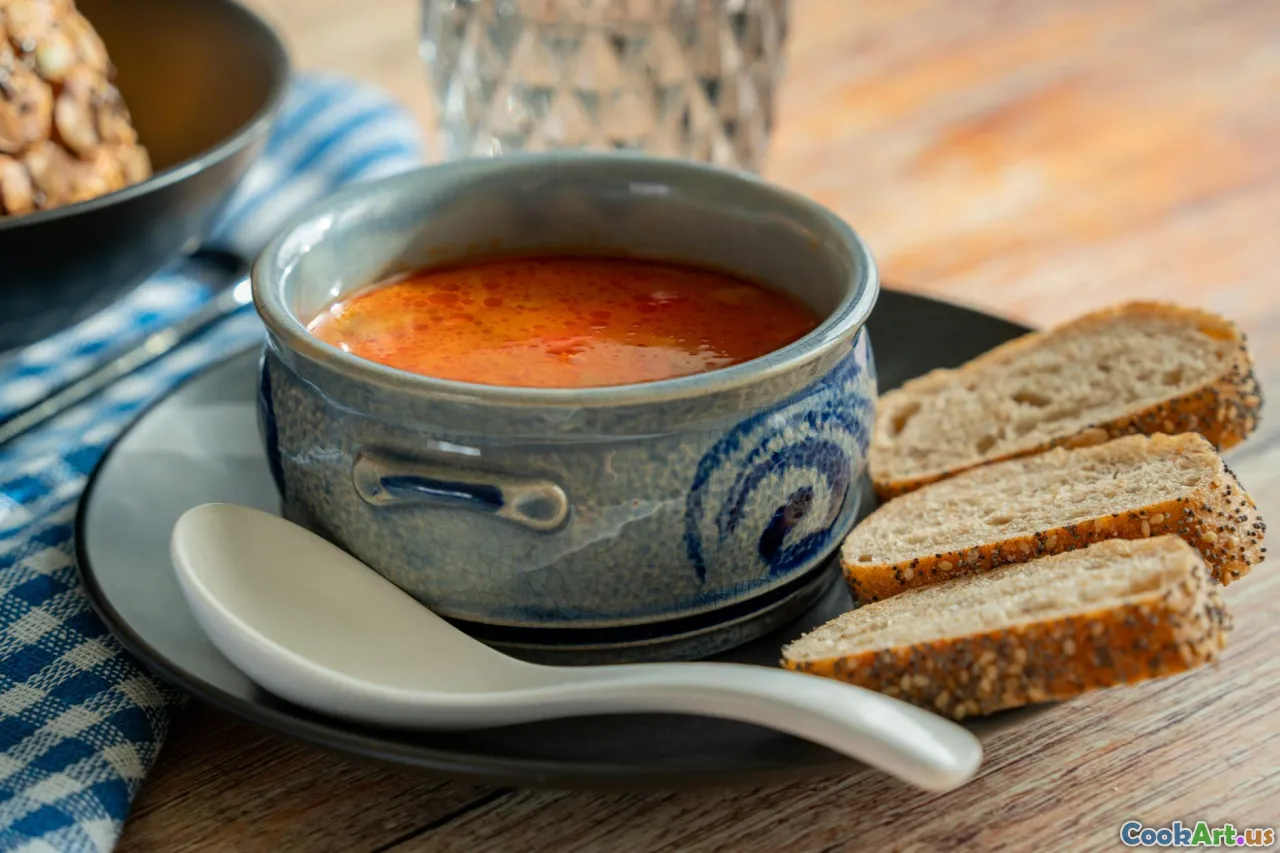
Деревенский Лецсо и Сочные Медальоны из Колбасы
(Rustic Village Lecso & Juicy Sausage Medallions)
(0 Обзоры)0
872
август 10, 2025
Сообщить о проблеме
Ингредиенты
-
350 grams Колбаса (копченая, сырая, толстая)
(Hungarian kolbász or Polish kielbasa ideal; use your local spicy sausage for substitute)
-
2 medium Лук
(White or yellow, peeled and finely sliced)
-
2 large Красный болгарский перец
(Deseeded and thickly sliced)
-
1 large Жёлтый болгарский перец
(Deseeded, thickly sliced for color contrast)
-
4 large Помидоры Рома
(Fresh, ripe; can substitute with 400g of canned plum tomatoes in less ideal seasons)
-
3 pieces Чесночные зубчики
(Тонко нарезанный)
-
1.5 tbsp Сладкая копченая паприка
(Предпочитаемая венгерская сладкая паприка)
-
2 tbsp подсолнечное масло
(Нейтральное масло или любое безароматное масло)
-
1 tsp Соль
(Регулируйте по вкусу)
-
0.5 tsp Чёрный перец
-
0.25 tsp Острая паприка или кайенский перец
(Добавляет нежное тепло)
-
2 tbsp Свежая петрушка
(Рубленый, для украшения)
-
4 slices Хрустящий деревенский хлеб
(For serving, dunking, and tradition)
(Hungarian kolbász or Polish kielbasa ideal; use your local spicy sausage for substitute)
(White or yellow, peeled and finely sliced)
(Deseeded and thickly sliced)
(Deseeded, thickly sliced for color contrast)
(Fresh, ripe; can substitute with 400g of canned plum tomatoes in less ideal seasons)
(Тонко нарезанный)
(Предпочитаемая венгерская сладкая паприка)
(Нейтральное масло или любое безароматное масло)
(Регулируйте по вкусу)
(Добавляет нежное тепло)
(Рубленый, для украшения)
(For serving, dunking, and tradition)
Питательная ценность
- Порции: 4
- Размер порции: 1 filled bowl (350g)
- Calories: 490 kcal
- Carbohydrates: 32 g
- Protein: 22 g
- Fat: 29 g
- Fiber: 6 g
- Sugar: 12 g
- Sodium: 960 mg
- Cholesterol: 55 mg
- Calcium: 65 mg
- Iron: 3 mg
Инструкции
-
1 - Prepare All Fresh Ingredients:
Wash and slice peppers, onion, and tomatoes. Cut sausage into 2cm thick medallions, and finely slice garlic.
-
2 - Sear the Sausage Medallions:
Heat 1 tbsp sunflower oil in a wide, deep pan over medium-high. Sear sausage medallions on each side until golden brown. Remove, set aside on a plate.
-
3 - Sauté the Onions & Garlic:
Lower heat to medium, add remaining oil and onions. Sauté for 4 minutes until soft and slightly golden, then stir in garlic for 1 more minute.
-
4 - Add Paprika, Peppers & Tomatoes:
Sprinkle in both paprikas, salt, and pepper. Quickly mix well, then add all sliced peppers and tomatoes. Stir to coat in seasoned oil and gently sauté.
-
5 - Simmer Village Style Lecso:
Turn heat to low, cover, and simmer lecso gently. Stir occasionally, allowing tomatoes to break down and peppers to grow tender. Remove lid for last 5 minutes to thicken.
-
6 - Finish with Sausage Medallions:
Nestle the sausage medallions back into the stew in the last minutes of cooking. Gently heat through until flavors meld.
-
7 - Plate and Enjoy:
Scatter with fresh parsley and serve hot — accompanied by slices of rustic, crusty bread for an authentic Hungarian countryside experience.
Wash and slice peppers, onion, and tomatoes. Cut sausage into 2cm thick medallions, and finely slice garlic.
Heat 1 tbsp sunflower oil in a wide, deep pan over medium-high. Sear sausage medallions on each side until golden brown. Remove, set aside on a plate.
Lower heat to medium, add remaining oil and onions. Sauté for 4 minutes until soft and slightly golden, then stir in garlic for 1 more minute.
Sprinkle in both paprikas, salt, and pepper. Quickly mix well, then add all sliced peppers and tomatoes. Stir to coat in seasoned oil and gently sauté.
Turn heat to low, cover, and simmer lecso gently. Stir occasionally, allowing tomatoes to break down and peppers to grow tender. Remove lid for last 5 minutes to thicken.
Nestle the sausage medallions back into the stew in the last minutes of cooking. Gently heat through until flavors meld.
Scatter with fresh parsley and serve hot — accompanied by slices of rustic, crusty bread for an authentic Hungarian countryside experience.
Подробнее о: Деревенский Лецсо и Сочные Медальоны из Колбасы
Village Style Lecso with Sausage Medallions: Story, Tips & Culture
Lecso, a one-pan countryside comfort food from Hungary, is a celebration of simple ingredients and fire-bright flavors. Villagers across Eastern and Central Europe welcome late summer and autumn with this rustic stew teeming with ripe peppers, tomatoes, onions, and – most prized – slices of smoky, sizzling sausage. This particular riff on lecso elevates tradition by searing sausage into lush, juicy medallions that nestle back into the fragrant stew just before serving, fattening its flavor with unmistakable authenticity.
Traditional Roots and Cultural Significance
Lecso (pronounced ‘leht-cho’) is far more than a stew—it’s a culinary emblem of Hungarian farm life and generosity. Originally cooked outdoors over wood fires during communal gatherings of harvesting season, lecso used what the fields gave in abundance: lush sweet peppers, fresh homegrown tomatoes, onions, and the family’s secret weapon—a ring of dense, garlicky, home-cured sausage. The dish’s roots trace back to the 19th century, but its kin—in Slovakia, Serbia, Austria, and Romania—testify to lecso’s wide influence.
Villages would bubble up massive pots of lecso, meant for sharing, dunking, and hearty eating with hunks of day-old crusty bread. Each house had its bolder or gentler versions, and cooks took pride in experimenting with ratios and additions. Spices and sausage choice announced origins: the celebrated Hungarian smoked kolbász or spicy Debreceni, both launching lecso into savory stardom.
Tips, Variations, and Notes
- Sausage matters: Traditional smoked Hungarian sausage has a very particular bite—paprika-forward, subtly garlicky, and robustly savory. Still, you can substitute with Polish kielbasa, Spanish chorizo, or any firm, smoky, uncooked sausage you love. Vegetarian? Smoked tofu or mushrooms take up the lecso sauce beautifully.
- Don’t rush the simmer: Lecso’s hallmark is its rustic, rich texture. Ideally, the tomatoes should collapse into a gentle stew— not disintegrate into soup. High heat disrupts this; a patient simmer makes the flavors rounder and deeper.
- Paprika power: The key flavor agent is good-quality (preferably Hungarian) sweet smoked paprika. Fresh paprika delivers depth and color not found in older tins. If you like it punchy, add a bit of hot paprika but taste as you go.
- Fresh is best: Use ripe summer peppers and tomatoes during their season for a true sunlight-sweetness. But don't let that stop your cravings in winter; high-quality canned tomatoes or grilled jarred peppers can create a fine lecso.
- Bread & sides: For tradition, serve lecso with thick, rustic bread—great for mopping up juices. Some villages lay a spoon of sour cream on top, while others tuck in a handful of pearl barley or rice for heartiness.
- Storage: Leftover lecso often tastes better the next day after an overnight meld in the fridge. Refrigerate airtight for up to three days.
Unique Aspects and Personal Thoughts
Lecso’s unique beauty lies in its sense of time and place. It’s unwaveringly local—yet endlessly adaptive. Delivering surprise in the way paprika and sausage intertwine, lecso charms with unpretentious, satisfying flavors that reflect a time when folks cooked what they had, made it stretch, and made it memorable. For me, lecso is the scent of late summer evenings and shared kitchen tables, as well as the deep hum of pepper harvests and autumn revelry.
Village Style Lecso with Sausage Medallions is more than a meal, it’s heritage served by the ladleful: smoky, subtly spicy, and layered with history. Whether enjoyed on a bustling Budapest street or recreated in your home kitchen with pantry adaptations, it’s a dish that connects you straight to the heart of countryside hospitality. Gather your friends, serve up bowls with extra bread, and let the aroma tell a thousand stories.
























